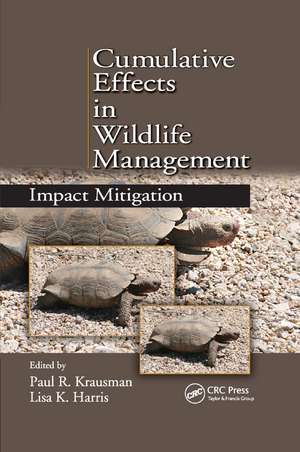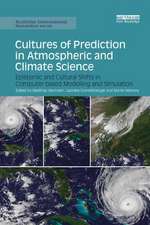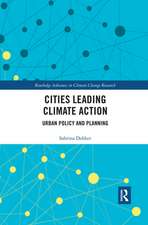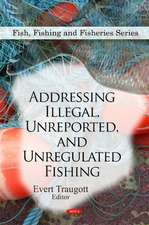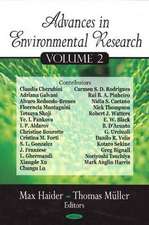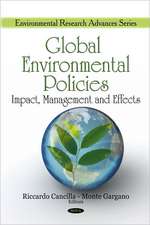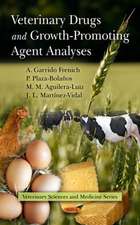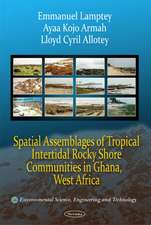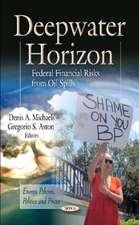Cumulative Effects in Wildlife Management: Impact Mitigation
Editat de Paul R Krausman, Lisa K. Harrisen Limba Engleză Paperback – 19 sep 2019
Divided into two parts, Cumulative Effects in Wildlife Management emphasizes the importance of recognizing cumulative effects and highlights the necessity of their bearing on future policy. It begins with an outline of the differences between direct, indirect, and cumulative effects of anthropogenic impacts on wildlife habitat and addresses the similarities and differences in US and Canadian policies, legal and economic ramifications, and the confusion that stems from lack of consideration, communication, and forward planning. Section 1 also describes the current standard means of quantifying cumulative effects as proposed by the Council on Environmental Quality.
Section 2 presents a series of case studies that deepen our appreciation of how anthropogenic influences interconnect and how this heightened level of understanding influences our ability to make informed decisions. Case studies include cumulative effects in the Canadian Arctic, border issues with Mexico, suburban and exurban landscapes, scenic resources, and the cumulative impacts of energy development on sage-grouse.
Without a conscious knowledge of what is happening around us, we will not be able to incorporate an effective land ethic, and natural resources will be the ultimate loser. Cumulative Effects in Wildlife Management brings to light the crucial connections between human expansion and habitat destruction for those managers and practi
Preț: 489.12 lei
Preț vechi: 575.43 lei
-15% Nou
Puncte Express: 734
Preț estimativ în valută:
93.60€ • 97.60$ • 77.79£
93.60€ • 97.60$ • 77.79£
Carte tipărită la comandă
Livrare economică 21 martie-04 aprilie
Preluare comenzi: 021 569.72.76
Specificații
ISBN-13: 9780367383015
ISBN-10: 0367383012
Pagini: 288
Dimensiuni: 156 x 234 x 18 mm
Greutate: 0.45 kg
Ediția:1
Editura: CRC Press
Colecția CRC Press
ISBN-10: 0367383012
Pagini: 288
Dimensiuni: 156 x 234 x 18 mm
Greutate: 0.45 kg
Ediția:1
Editura: CRC Press
Colecția CRC Press
Public țintă
Academic and Professional ReferenceCuprins
Understanding Cumulative Effects. Case Studies. References.
Notă biografică
Paul R. Krausman received his B.S. in zoology from the Ohio State University, M.S. in wildlife science from New Mexico State University, and Ph.D. from the University of Idaho. He has taught and conducted research at Auburn University, the University of Arizona, Wildlife Institute of India, and the University of Montana. He has concentrated his research and teaching on wildlife management, especially in arid areas in the Southwest, North Africa, and India, and in areas where there are significant anthropogenic influences on wildlife habitats. Paul is a certified wildlife biologist, active with The Wildlife Society (TWS) (currently president-elect), a TWS Fellow, and received the Leopold Award and Medal. He has published hundreds of scientific articles, reports, and papers, and several books. He is currently the Boone and Crockett Professor of Wildlife Conservation at the University of Montana, Missoula.
Lisa K. Harris, Ph.D., received her degrees from the University of Chicago and the University of Arizona. She has developed a successful environmental consulting firm guiding government agencies through compliance with the National Environmental Protection Act, Endangered Species Act, National Historical Preservation Act, and other environmental regulations. Identifying and analyzing cumulative effects are a constant issue in her work. A prolific writer with wide-ranging interests, Dr. Harris has published scientific articles on natural resource conservation, land use modeling, effects of military impacts on endangered species, cactus transplantation, as well as popular press articles and essays on adventure travel, parenting, health and fitness, cycling, and food. She lives in Tucson, Arizona, with her two daughters and a menagerie of four-footed friends. Whenever possible, she slips on a backpack and heads to road’s end.
Lisa K. Harris, Ph.D., received her degrees from the University of Chicago and the University of Arizona. She has developed a successful environmental consulting firm guiding government agencies through compliance with the National Environmental Protection Act, Endangered Species Act, National Historical Preservation Act, and other environmental regulations. Identifying and analyzing cumulative effects are a constant issue in her work. A prolific writer with wide-ranging interests, Dr. Harris has published scientific articles on natural resource conservation, land use modeling, effects of military impacts on endangered species, cactus transplantation, as well as popular press articles and essays on adventure travel, parenting, health and fitness, cycling, and food. She lives in Tucson, Arizona, with her two daughters and a menagerie of four-footed friends. Whenever possible, she slips on a backpack and heads to road’s end.
Descriere
Discussing the array of issues associated with the cumulative effects of wildlife management projects and subsequent developments in surrounding habitats, this book outlines methods to address these impacts in wildlife management. Chapters cover definitions, assessment approaches, National Environmental Policy Act (NEPA), quantification of effects both spatially and temporally, regulation and monitoring techniques at home and abroad, economic considerations, and the impact of shortfalls. Each chapter includes illustrative examples including anthropogenic impacts on freshwater fish and cumulative effects on sage-grouse, barrenground caribou, and bighorn sheep.
